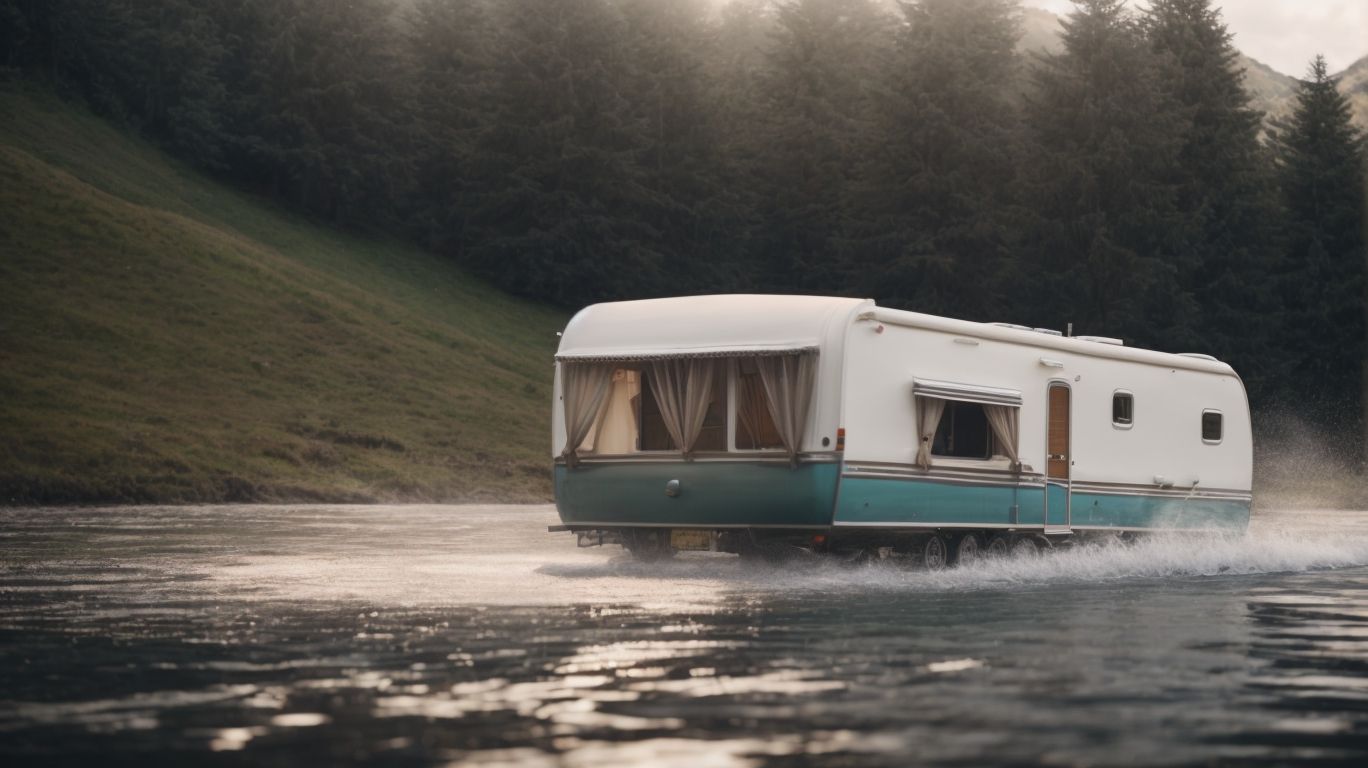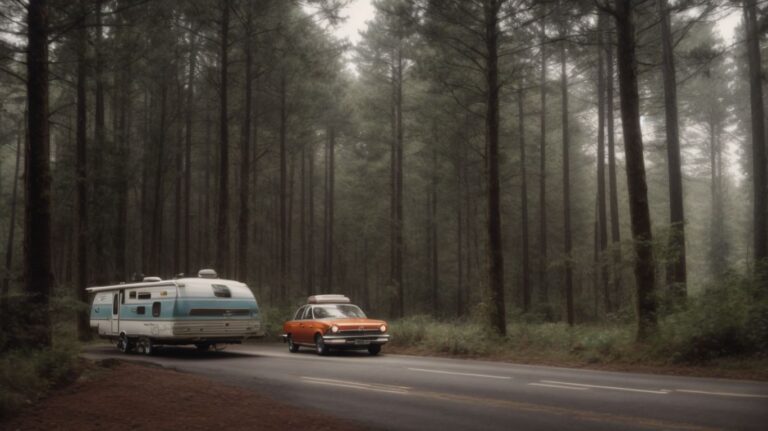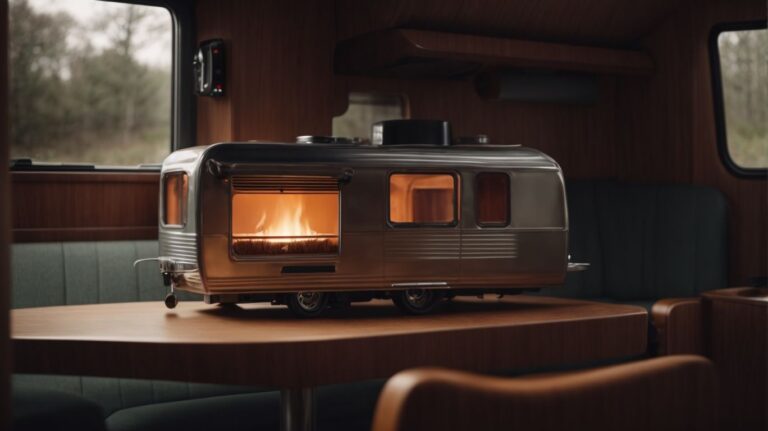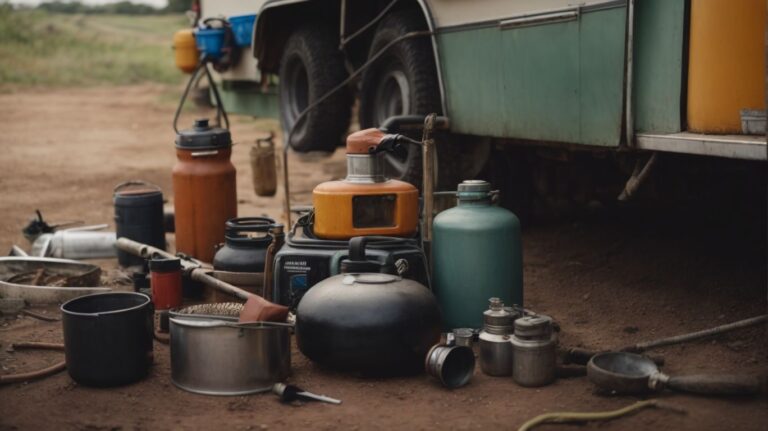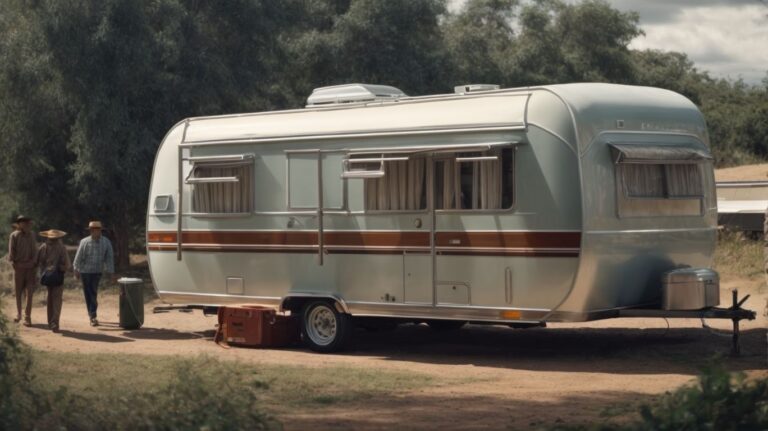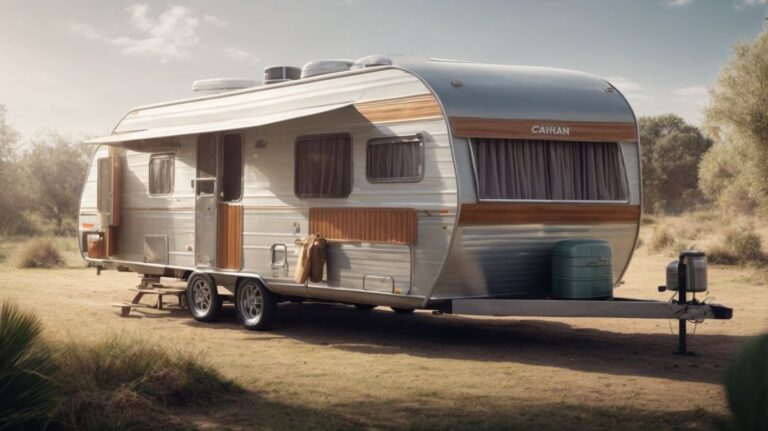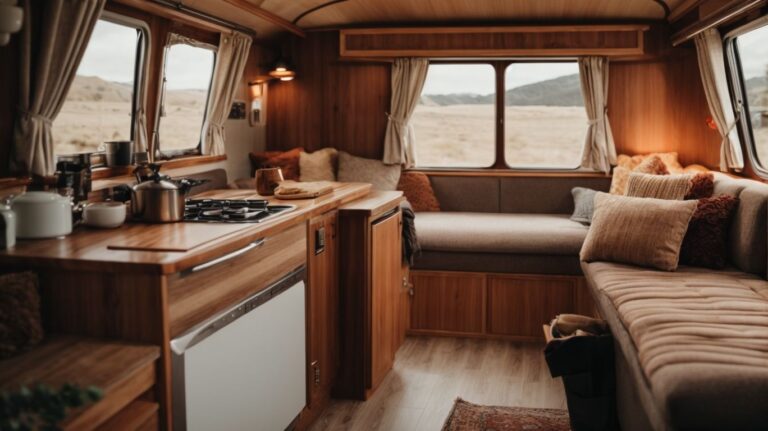Understanding the Causes of Caravan Leaks: Why Do They Happen?
Are you a caravan owner looking to protect your investment and ensure a safe and comfortable travel experience?
Understanding the causes of caravan leaks is essential in preventing costly damage and health risks.
From age and wear and tear to faulty plumbing systems, there are several common culprits behind these leaks.
We will explore the potential consequences of a caravan leak, how to identify them, and most importantly, how to prevent them.
Stay tuned to learn more about keeping your caravan leak-free!
Key Takeaways:
What Is a Caravan Leak?

Credits: Motorcaravanning.Com – Carl Nelson
Motion Activated RV Step Lights, 10 LED Battery Operated Motorhome Motion Sensor led Light Strip, Magnetic Night Light Bar for Motorhome Travel,Travel Trailers, Camper (2 Pack)
- 【Infrared Induction Motion Detection】Motion sensor light on the PIR sensor can detect human movement, 10 feet once your approach is detected, the rv step lights will automatically turn on in the dark, in the absence of detected motion or other light sources, 18 seconds after the automatic shutdown, a large degree of power savings and improved durability.
Camco TST MAX RV Toilet Treatment Drop-INs - Control Unwanted Odors & Break Down Waste and Tissue - Safe Septic Tank Treatment - Orange Scent, 30-Pack (41183)
- Toilet Deodorizer With Reactive Odor-Eliminating Technology: Experience a powerful RV odor eliminator that stops RV black tank odors for up to 7 days. Just (1) toilet drop in treats camper toilets with up to a 40-gallon tank.
THANSTAR Collapsible Dish Drying Rack Portable Dinnerware Drainer Organizer for Kitchen RV Campers Travel Trailer Space Saving Kitchen Storage Tray
- 【Food Grade Material】Made from eco-friendly PP+TPR material that is BPA Free and Food-Grade. The flexible material allows the dish strainers for kitchen counter to collapse flat for easy space-saving and storage, making the most of your kitchen countertop.
Camco RhinoFLEX 20-Ft RV Sewer Hose Kit - Features Clear Elbow Fitting w/Removable 4-in-1 Adapter - Connects to 3” Slip or 3”/3.5”/4” NPT Threaded Sewer Connection (39742)
- Superior RV Tank Dumping: Streamline RV holding tank dumping with Camco’s RhinoFLEX 20' Camper Sewer Hose Kit. Built tough & flexible, this all-inclusive RV septic hose system provides simple & effective tank dumping on your camping adventures.
Camco Tastepure RV Water Filter - New & Advanced RV Inline Water Filter with Flexible Hose Protector - GAC & KDF Water Filter - Made in USA - Camping Essentials for Fresh Drinking Water (40043)
- Advanced 6-Step Filtration Technology: Experience the extraordinary power of Hex-Flow Technology & its remarkable 6-step filtration process. Every layer works together to provide you with water that is exceptionally clean.





A caravan leak refers to the unwanted entry of water into the interior spaces of a caravan, typically caused by damaged seals, cracks, or holes in the structure.
Water ingress in a caravan can lead to a range of devastating consequences, both aesthetically and functionally. Continuous exposure to water can result in hidden mold growth, musty odors, and damp, which not only compromise the living conditions but also pose serious health risks. The structural integrity of the caravan is at stake, as the water can seep into the walls, floors, and ceilings, causing rot, delamination, and potentially irreparable damage.
What Are the Common Causes of Caravan Leaks?
Caravan leaks can stem from various factors, including sealant degradation, damaged roof apertures, or compromised window frames that allow water ingress.
One of the primary reasons for leaks in caravans is the breakdown of the sealant used to create watertight seals. Over time, exposure to UV rays, extreme temperatures, and general wear and tear can cause the sealant to crack and lose its adhesive properties, creating openings for water to seep through. Additionally, structural damage to the roof, walls, or windows can compromise the integrity of the caravan’s exterior, providing pathways for water infiltration. Faulty components, such as poorly installed vents or plumbing fixtures, can also contribute to leak issues by not being properly sealed or secured.
Age and Wear and Tear
The age and wear and tear of a caravan can contribute to sealant degradation, which may lead to water leaks and potential structural damage over time.
As caravans are exposed to the elements, their seals face constant threat from UV rays, temperature fluctuations, and general deterioration. Without proper maintenance, these seals can wear down, harden, and crack, allowing moisture intrusion and compromising the integrity of the structure. Regular inspections are vital to catch early signs of seal failure before they escalate into costly water leaks and extensive damage. By proactively checking and replacing worn seals, owners can prolong the lifespan of their caravan and avoid major repair issues.
Poor Maintenance
Neglecting proper maintenance routines can result in undetected water leaks, highlighting the necessity of professional inspections to identify and address potential issues promptly.
Water leaks in caravans, if left unnoticed, can lead to severe damages, compromising the structural integrity of the vehicle. Regular professional inspections not only help in spotting these leaks early on but also ensure that necessary repairs are carried out efficiently to prevent further deterioration. Professional inspectors possess the expertise to assess all key areas prone to leaks, such as roofs, windows, and plumbing, offering comprehensive evaluations that homeowners might overlook. By entrusting your caravan to skilled professionals, you can safeguard your investment and enjoy worry-free travels knowing that your vehicle is in prime condition.
Damaged Seals and Gaskets
Damaged seals and gaskets can compromise the waterproofing of a caravan, necessitating resealing measures to prevent water leaks and subsequent damage.
When these vital components wear out over time or become damaged due to wear and tear, they expose your caravan to potential water ingress, leading to costly repairs and structural issues. By regularly inspecting and resealing the seals and gaskets, you can maintain the structural integrity of your caravan and keep it protected from the elements.





Resealing is a crucial maintenance task that involves removing the old sealant, cleaning the surfaces thoroughly, and applying a fresh layer of sealant to create a watertight barrier. This process not only prevents water leaks but also helps in preserving the longevity of your caravan by safeguarding it from moisture-related damage repair.
Cracks or Holes in the Exterior
Cracks or holes in the exterior surfaces of a caravan can serve as entry points for water, underscoring the importance of preventive measures to detect and seal such vulnerabilities.
Water ingress due to these structural flaws can lead to extensive damage, compromising the integrity of the caravan’s interior. To prevent such issues, regular inspections are crucial in identifying potential weak points.
Preventive maintenance routines should include carefully examining all external surfaces, paying close attention to vulnerable areas prone to cracks or holes.
Faulty Plumbing or Water Systems
Issues with the plumbing or water systems within a caravan can lead to leaks and water damage, necessitating thorough examination and repair of the affected components.
Leaking water can not only cause physical damage to the structure of the caravan but also lead to mold and mildew growth, which can be harmful to health. Water leaks can result in increased humidity levels inside the caravan, promoting the growth of bacteria. Regular maintenance of the plumbing system and prompt repair of any leaks are crucial to avoid these issues.
How Can You Identify a Caravan Leak?
Identifying a caravan leak involves inspecting for visible water damage, musty odors, damp spots, or mold and mildew growth in the interior spaces.
Often, the first sign of a caravan leak is the appearance of water stains on the walls or ceiling. These stains can vary in size and color, ranging from light brown to dark yellow, indicating prolonged water ingress.
A distinctive musty smell, akin to that of damp or mildew, can permeate the air inside the caravan, particularly in enclosed areas like closets or cabinets.
While inspecting for leaks, pay attention to any soft or spongy areas on the walls or floor, as these could be indicators of water damage.





To ensure a thorough examination, it is essential to clean and declutter the caravan’s interior to reveal hidden leaks that may be lurking beneath furniture or carpets.
Visible Water Damage
Visible water damage on surfaces like ceilings or walls can serve as a clear indicator of a caravan leak, prompting immediate investigation and repair to prevent further damage.
Water leaks in a caravan are not just a nuisance; they can lead to severe structural issues if left unattended. The moisture from leaks can weaken the caravan’s framework, causing wood rot and compromising the integrity of the walls and ceilings over time. Addressing these leaks promptly is crucial to avoid extensive damage that may result in costly repairs. It’s important to identify the source of the leak, whether it be from a damaged roof seal, window seal, or plumbing fixture, and take swift action to seal it to prevent any further water infiltration. Regular inspections and maintenance are key to ensuring the longevity and safety of your caravan.
Musty Odors
The presence of musty odors within a caravan can signal mold or mildew growth due to water leaks, necessitating prompt inspection and remediation to prevent health risks.
If left unchecked, mold and mildew can rapidly spread, posing serious health risks, especially for individuals with respiratory conditions. Addressing the underlying water leaks is essential to halt the mold’s growth cycle.
It is crucial to locate and fix the source of moisture to prevent recurrent mold problems. Regularly inspecting areas prone to water leaks, such as around windows, roofs, and plumbing fixtures, can aid in early detection and prevention of mold infestations. Take proactive steps to maintain a dry environment within the caravan to safeguard against potential health hazards.
Damp or Soft Spots on Walls or Floors
Detecting damp or soft spots on caravan walls or floors may signify water intrusion affecting the timber frame structure, prompting immediate investigation and repair to prevent rot or further damage.
Water leaks can wreak havoc on timber frames, leading to structural decay and compromising the integrity of the entire caravan. It’s crucial to address any signs of dampness promptly to avoid extensive damage.
Rot caused by prolonged exposure to moisture can weaken the timber, posing safety risks and potentially resulting in costly repairs. By identifying and rectifying damp spots early, you can safeguard the structural stability and longevity of your caravan.
Mold or Mildew Growth
The presence of mold or mildew growth in areas like J-moulds or around roof apertures can indicate water leaks within a caravan, necessitating thorough cleaning and resealing to address the issue.





When mold or mildew start to appear in these specific areas, it’s often a telltale sign that water is finding its way into your caravan through J-moulds or other vulnerable points. Left unattended, these leaks can lead to extensive damage and costly repairs.
To tackle the problem effectively, begin with a detailed cleaning process to remove all traces of mold and mildew. Use appropriate cleaning agents and tools to ensure thoroughness.
Once the affected areas are clean, it’s crucial to focus on resealing them properly. This step involves inspecting the J-moulds and other potential entry points for water, then applying a high-quality sealant to prevent any further ingress.
What Are the Potential Consequences of a Caravan Leak?
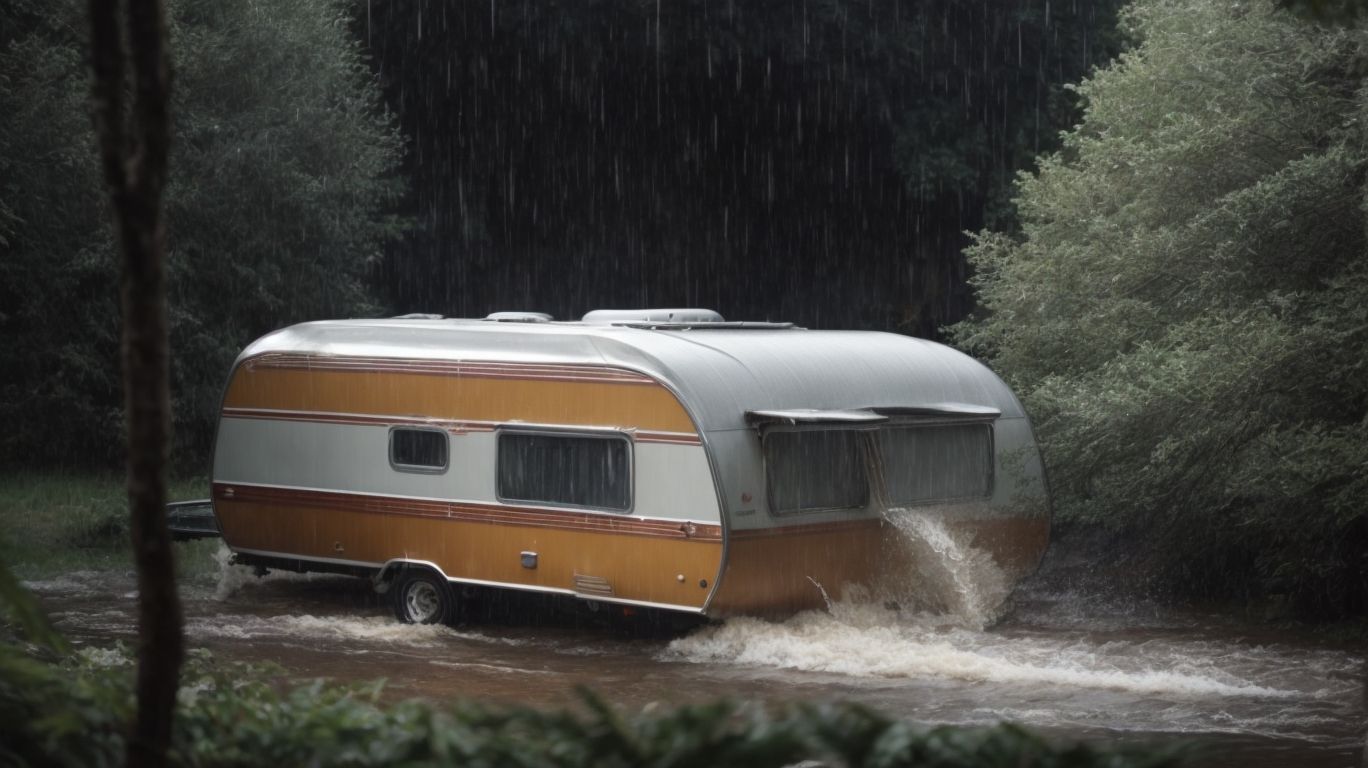
Credits: Motorcaravanning.Com – Arthur Torres
A caravan leak can lead to structural damage, health risks from mold and mildew exposure, and significant repair bills if not promptly addressed.
Water damage resulting from a leak in a caravan can wreak havoc on the internal structure, weakening the walls, floors, and ceilings over time. Neglecting the issue can escalate these damages, compromising the safety and stability of the entire vehicle.
The presence of mold and mildew due to dampness can pose serious health risks, especially for individuals with respiratory conditions or allergies. The spores released by mold growth can lead to respiratory problems, skin irritation, and exacerbate existing health issues.
Timely intervention to resolve leaks and conduct necessary repairs is crucial to prevent further deterioration and protect both the occupants’ health and finances.





Structural Damage
Caravan leaks can result in structural damage to components like the roof, walls, and flooring, necessitating immediate repair to prevent further deterioration and ensure the caravan’s integrity.
Water damage, if left unattended, can weaken the caravan’s structure, leading to potential safety hazards and costly repairs down the line. Moisture seeping into the walls or ceiling can weaken the framework, compromising the overall stability of the van.
- Leaks can also promote the growth of mold and mildew, further deteriorating the interior and posing health risks to occupants.
- Prompt repairs are crucial to mitigate these risks and preserve the value of the caravan.
Health Risks from Mold and Mildew
Exposure to mold and mildew resulting from caravan leaks can pose health hazards such as respiratory issues or allergies, underscoring the importance of comprehensive cleaning and remediation.
When left unchecked, mildew and mold can thrive in damp environments, leading to potential water damage and compromising the structural integrity of the caravan. Prevention is key, and ensuring proper ventilation is crucial in minimizing moisture levels and deterring mold growth.
Regular inspection of hidden corners and crevices can help in early detection of any mold infestations, prompting immediate action to mitigate risks. It’s essential to use suitable cleaning agents and protective gear when handling mold, as exposure can exacerbate existing health conditions and trigger respiratory distress. By incorporating these practices into your caravan maintenance routine, you safeguard the health and well-being of all occupants.
Costly Repairs
Neglecting water damage repairs in a caravan can lead to escalating costs and the need for extensive cosmetic enhancements to restore the vehicle’s appearance and functionality.
When left unaddressed, water damage can penetrate deep into the structure of the caravan, causing structural integrity issues that are not only costly but also compromise the safety of the vehicle.
Timely repairs not only prevent further damage but also save you from hefty repair bills down the line. Additionally, cosmetic enhancements such as repainting or replacing damaged interior elements can significantly improve the caravan’s resale value and overall aesthetic appeal.
How Can You Prevent Caravan Leaks?
Preventing caravan leaks involves regular maintenance and inspections, proper storage practices, prompt issue resolution, and investing in quality materials and seals for enhanced protection.
In terms of caravan maintenance, one of the crucial aspects is inspecting the roof seals regularly to ensure they are in good condition and effectively keeping water out. It’s also essential to address any minor leaks as soon as they are discovered to prevent them from escalating into bigger problems. Furthermore, choosing durable materials for your caravan’s construction can significantly reduce the likelihood of water ingress. Incorporating good storage habits such as keeping your caravan covered when not in use and ensuring proper ventilation can also help prevent leaks over time.





Regular Maintenance and Inspections
Regular inspections of seals, gaskets, and roof components are essential to identify and address potential leaks proactively, preserving the caravan’s integrity and longevity.
By conducting routine maintenance checks and seal inspections on your caravan, you can ensure that any vulnerabilities are detected early on, preventing water leaks that could lead to costly damage. The inspection process involves examining all roof seals, gaskets, and other components for wear, tears, or signs of deterioration. Timely intervention can help maintain the waterproofing integrity of your caravan, safeguarding it against the harmful effects of water infiltration. Addressing any issues promptly not only protects your investment but also prolongs the lifespan of your caravan.
Proper Storage and Protection
Storing a caravan in a well-ventilated and protected environment can safeguard it against moisture buildup and potential water ingress, preserving its structural integrity and condition.
Proper ventilation is crucial to prevent mold and mildew from forming inside the caravan. Inadequate airflow can result in musty odors and damage to furniture and upholstery. Implementing protective measures such as using moisture absorbers and dehumidifiers can effectively combat excess humidity. Regularly checking for and repairing any water leaks is paramount to avoid ongoing structural issues. When purchasing a used caravan, it’s especially important to assess its storage history and address any existing moisture-related concerns to ensure long-term durability.
Promptly Address Any Issues or Damage
Addressing any signs of water damage promptly can prevent issues like rot, mold growth, or structural decay, ensuring the caravan’s longevity and minimizing repair costs.
Swift action after discovering water damage is crucial to safeguard your caravan from more severe problems. The longer water damage is left unchecked, the higher the likelihood of rot spreading and weak spots forming in the structure. Mold growth due to dampness can pose health risks and compromise air quality inside the caravan.
- When handling water damage, remember to thoroughly dry affected areas to hinder mold growth and structural harm.
- Consider seeking professional assistance to assess and handle water damage, ensuring all underlying issues are addressed.
Invest in Quality Materials and Seals
Opting for quality materials and seals during caravan construction or maintenance can enhance water resistance, reduce the risk of leaks, and lower the likelihood of costly repairs.
When considering a used caravan, it is crucial to conduct a thorough inspection to assess the condition of the seals and identify any potential leak risks. By carefully examining the sealant used and its quality, you can preemptively address any issues and ensure a watertight enclosure. This proactive approach not only safeguards your investment but also provides peace of mind during your outdoor adventures.
Frequently Asked Questions
What are the common causes of caravan leaks?
The most common causes of caravan leaks are damaged seals, cracks in the roof or walls, and loose or missing screws and bolts.





Can a caravan leak be caused by improper installation?
Yes, a caravan leak can be caused by improper installation of components such as windows, vents, or awnings. If these are not installed properly, water can seep in through the gaps.
What types of weather can cause caravan leaks?
Caravan leaks can occur during heavy rain, snow, or hail, as well as extreme temperatures. It’s important to regularly check for leaks after experiencing severe weather conditions.
How does condensation contribute to caravan leaks?
Condensation can form inside a caravan when there is a temperature difference between the inside and outside. This can lead to moisture buildup and eventually cause leaks if not properly ventilated.
Are caravan leaks a common issue for all types of caravans?
Yes, caravan leaks can happen to all types of caravans, whether they are new or old, small or large. Regular maintenance and inspections can help prevent leaks from occurring.
Can I repair a caravan leak myself or do I need professional help?
It depends on the severity and cause of the leak. Small leaks caused by damaged seals or loose screws can be repaired by the owner, but larger leaks or those caused by structural damage may require the expertise of a professional.

